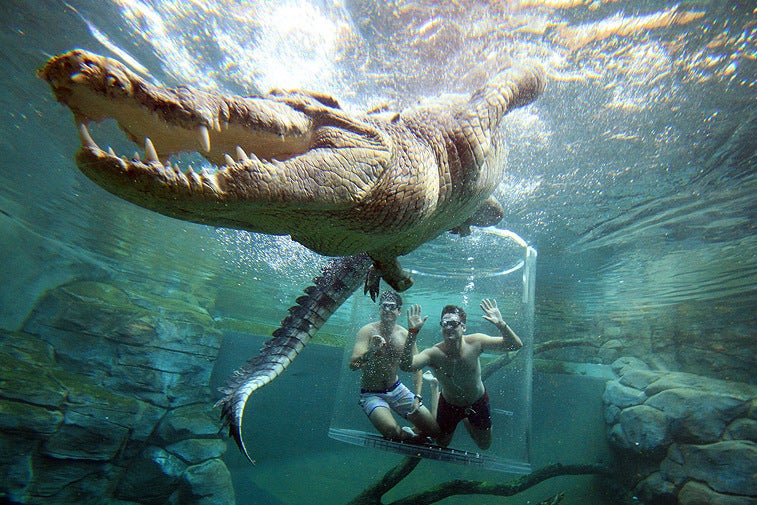The Independent's journalism is supported by our readers. When you purchase through links on our site, we may earn commission.
Crocosaurus Cove: Swimming with crocodiles at Darwin’s scariest attraction
Tourists can get up close and personal with the ultimate reptilian predator in Australia

Chopper’s dental hygiene is, frankly, disgraceful. But it’d take a brave dentist to suggest an electric toothbrush and regular flossing. When you’re face to face with a 5.5m-long saltwater crocodile, such professional dedication probably goes out of the window.
Getting in the water with Chopper under normal circumstances would mean almost certain death. Crocs have no emotions, and no fear of taking down large creatures to supplement their usual diet of turtles and fish. They will often wait in the murky shallows, learning the routine of any interloper stupid enough to come to the same spot on a regular basis, then pounce. They can move their entire body length in a second, then bite down with 66 teeth and a force of 33,800 newtons. For comparison, a lion or a great white shark can manage around 2,700 newtons.
The only thing protecting me from this fate at Chopper’s gnashers is a thin strip of Perspex, known hyperbolically as the Cage of Death. This especially unnerving piece of daredevilry is the star attraction of Darwin’s Crocosaurus Cove, which houses some of the biggest crocodiles on earth in the middle of the Northern Territory’s most notorious boozing street.
The idea is brilliantly simple: lower willing, paying guests into the cage with the crocs, then see what happens. And it doesn’t take long after I’ve splashed down for him to kick into gear.
He doesn’t come straight for me, but circles around. This is both a show of dominance and a sign that he knows he can’t penetrate the cage. Rattling the Perspex would take up too much energy, so instead he slowly glides round, and lines his black slit of an eye up with the narrow holes in the cage. If so much as a pinkie finger dares to go through that hole to investigate, Chopper will have it.
“Chops” is a favourite of the Crocosaurus Cove staff, although keeper Charlotte Price admits, “he’s probably not as attached to us as we are to him”. He’s an old boy, in his 80s, who survived the crocodile-hunting era that saw numbers reach critically low levels. It’s thought that, at one point, there were fewer than 3,000 left in the Northern Territory. A hunting ban was imposed in 1971, and now there are reckoned to be around 80,000.
But some of them, like Chopper, become ‘problem crocodiles’. In practice, this means they start hanging out around boat ramps and beaches, attacking boats or taking a few too many cattle. Capturing them and shifting them elsewhere is pointless – crocs are highly territorial and will just make their way back to what they’ve decided is their home turf. So the likes of Chopper end up on crocodile farms or, if they’re particularly gigantic, at Crocosaurus Cove.
Seeing Chopper up close, it’s obvious that he’s lost a fair few fights in his time. His skin is tough but scarred, and while his back feet look like those of a comedy dinosaur fancy dress costume, his front feet are just stumps. His neck is intimidatingly fat and his tail, that most powerful of engines, sweeps across the horizon with a sinister majesty.
But it’s his mouth that provokes the most awe – and definitely the most fear. Something disturbs the water behind him, and he launches himself at it with instinctive ferocity. It’s a bit of chicken – Crocosaurus Cove staff evidently like to spice things up a bit by feeding the crocs while humans are in the enclosure with them. And once the chicken is dangled between Chopper and the cage, I get to see what would await if the Perspex suddenly dissolved.
He opens wide, his throat not visible due to the valve that prevents him from drowning if he opens his mouth underwater. To swallow, he has to throw his head back like someone ostentatiously taking tablets. But the chances of any food still being alive by that stage are pretty slim.
It's virtually impossible not to shudder and recoil at this. There’s not the faintest question of survival in a straight fight against this 790kg prehistoric killing machine. Crocs stopped evolving long before humans came on the scene – they simply didn’t need to change the recipe that has long made them the apex predator of the tropics. And, as the cage lifts in retreat, he slowly returns to the bank to catch some sun. The old man has his territory to himself again, and all is fine with the world.
Travel essentials
Getting there
Etihad (etihad.com) flies from London Heathrow and Manchester, via Abu Dhabi, to key Australian cities such as Sydney, Melbourne and Brisbane. Connecting codeshares up to Darwin with Virgin Australia can be bundled into the ticket for around £980.
Staying there
Doubles at the central, tropical garden-surrounded Palms City Resort (palmscityresort.com) cost from AU$145 (£84).
More information
The Cage of Death experience, including entry to Crocosaurus Cove (crocosauruscove.com), costs AU$170 (£98) going solo, or AU$130 (£75) each entering as a duo.
Subscribe to Independent Premium to bookmark this article
Want to bookmark your favourite articles and stories to read or reference later? Start your Independent Premium subscription today.

Join our commenting forum
Join thought-provoking conversations, follow other Independent readers and see their replies